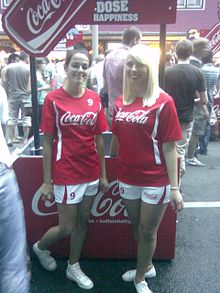Advertising campaign
Advertising campaigns are promotions by companies that offer products or services; they can be limited in time. The aim of advertising campaigns is generally to increase sales and profits as well as to strengthen the company's image and thus improve one's own market position. Advertising campaigns are also carried out to launch new products or services.
An advertising campaign is always based on a concept (advertising planning). The following framework conditions are defined in advertising planning:
- Advertising target
- Advertising strategy
- Advertising message
- budget
- Measures and media
- Period
The planning and implementation can be left to an advertising agency , in large companies this is entrusted to the in-house advertising and marketing department. A number of external service providers are also involved in the implementation of an advertising campaign . These can range from printers to web designers and recording studios . Which service providers are available depends on the choice of media.
Different channels and media are used to implement advertising campaigns :
- Advertisements in print media
- Radio and television commercials
- Brochures / flyers / leaflets
- Outdoor advertising (large area / city light / advertising column)
- PR / editorial PR / paid PR
- Cinema advertising
- Events / Promotion / Events / Testimonials
- Interception advertising
- Promotional items
- Internet advertising (websites / banner advertising)
- Direct mailing measures
- Telemarketing
- SMS / email
etc.
Depending on the target group and the orientation of the advertising campaign , individual media or a so-called media mix consisting of several media are used. Which media are actually used depends on the target group (s). So it doesn't make much sense to sell soup sachets via telephone marketing or to sell large-area printing machines.
Design and implementation
The advertising concept sets the general framework, according to which all design measures of an advertising campaign must be based. Roughly, the concept specifies the points Consumer Benefit (advantage for consumers), Reason Why (literally translated: "Reason why") and Tonality (conspicuousness, e.g. the use of stimulus words ).
The requirements for successful advertising are:
- Attention Power
- relevance
- credibility
- Retention
- continuity
The more advertising meets these criteria, the greater the chance that it will do what it is supposed to do. With the conception of a copy strategy (text strategy) one can develop effective advertising in line with these requirements. The starting point is the copy analysis. In order to be able to carry out a precise and targeted copy analysis, a focus should also be placed on the positioning of the copy strategy points (consumer benefit, reason why, tonality), as well as on the desired target group that is to be reached.
As an example, here is the copy strategy of an energy drink manufacturer:
-
Consumer benefit:
physical and mental fitness. -
Reason Why:
The invigorating effect of the ingredients taurine and caffeine. -
Tonality:
humorous, witty, witty, ironic.
According to Hans Christian Weis, the process of advertising planning and implementation can be outlined as follows:
- Marketing goals
- Advertising goals
- Advertising budget
- Determination of the advertising objects
- Determination of the advertising subjects
- Definition of the advertising message
- Selection of advertising material
- Pretest
- Choice of advertising media
- Choice of time and region
- Advertising implementation
- Advertising control
After an advertising campaign has been completed , a campaign analysis and advertising success control is usually carried out . Depending on these results, future advertising campaigns are optimized, successful campaigns are often repeated or extended to other target groups or media.
